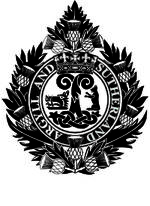| 5th (Renfrewshire) Battalion | |
|---|---|
 Cap Badge of the Argyll and Sutherland Highlanders | |
| Active |
1908—1918 1920—1947 |
| Country | |
| Branch | |
| Role | Infantry |
| Size | Battalion |
| Engagements | |
The 5th (Renfrewshire) Battalion Princess Louises's Argyll and Sutherland Highlanders was an infantry unit of the Territorial Force, later the Territorial Army. The battalion's predecessor was formed in 1860, and was known under its familiar name in 1908 following the formation of the Territorial Force. The battalion was finally disbanded in 1921 following the formation of the Territorial Army.
For the predecessor of the battalion, see; 1st Renfrewshire Rifle Volunteers (1860-1908).[1][2]
History[]
Background[]
In 1907, Secretary of State for War Richard Haldane announced a series of reforms, which would effect mostly the Volunteers and Yeomanry. These two groups were merged to form the "Territorial Force". On 1 April 1908 the Territorial Force was born. These reforms formed fourteen divisions, fourteen mounted brigades, and coastal defence troops. As part of these reforms, all of the volunteer battalions were renamed lossing their "volunteer" title and gaining regional or regular titles.[1][2][3]
Prewar[]
In 1908 following the formation of the Territorial Force, the former 1st (Renfrewshire Volunteers) Battalion was redesignated as the 5th Battalion.[1][2][3] The battalion then had the following structure;[1][3]
- Battalion Headquarters, A-D, and F-H Companies based in Greenock
- E Company in Port Glasgow
- H Company detachments in Inverkip
The next year, the battalion was renamed as the 5th (Renfrewshire) Battalion. After formation, the battalion was the only of the regiment to be assigned to the Black Watch Infantry Brigade of the Scottish Coastal Defences.[1][2][3] By 1914, the staff as follows;
- Honourable Colonel, Sir H Shaw-Stewart, Bt CB[1][4]
- Commanding Officers, Colonel H D McIntyre, Bt[4]
World War I[]
Following the declaration of war in July, the territorial force was duplicated. During the war, the battalion formed three duplicates all of which will be shown below.[1][1]
1/5th (Renfrewshire) Battalion[]
The 1/5th (Renfrewshire) Battalion was formed in July 1914 from the separation of the former 5th battalion. In August the battalion was based in Greenock and attached in the Army Troops role for the Black Watch Brigade of the Scottish Coastal Defences. The battalion kept control of the original A-D Companies.[1][5][6]
On 24 April 1915, the battalion moved to Dunfermline and transferred to the Highland Light Infantry Brigade of the Lowland Division. By May, the brigade was re-desgianted as the 157th Brigade within the 52nd (Lowland) Brigade. In June, the battalion sailed from Devonport to Gallipoli, going via Egypt (12 June) and Mudros (1 July). The battalion finally landed at Cape Helles on 3 July.[5] During the invasion, the battalion saw service in many actions including; Attack at Gully Ravine, Battle of Achi Baba Nullah, Battle of Krithia Nullahs, and finally the Evacuation from Cape Helles. Following this failed invasion, the battalion was evacuated to Mudros and finally arrived in Egypt in February 1916. After moving, the battalion moved to the Suez Canal and was assigned to canal defences.[5][6]
On 11 April 1918 the battalion along with the 52nd (Lowland) Division left Egypt and the battalion arrived on 17 April in Marseilles for service on the Western Front. On 26 August the battalion joined the 103rd Brigade within the 34th Division.[5] During their time on the Western Front, the battalion saw service during the following battles; Battle of Soissonais, Battle of Ooteghern, and finally the Battle of Tieghem.[5][6]
In 1918 following the end of the war, the battalion was put into suspended animation, they were based in Halluin.[5][6]
2/5th (Renfrewshire) Battalion[]
In 1914, following the duplication of the Territorial Force, the battalion was formed in Greenock. The battalion took control of E-H companies from the former 5th battalion. On 30 November 1915, the battalion was absorbed by the 2/8th Battalion within the 193rd Brigade of the 64th Division.[5][6]
3/5th (Renfrewshire) Battalion[]
In April 1915, the battalion was formed at their home station in Greenock as a 3rd line reserve battalion. On 8 April 1916, the battalion was designated as the 5th Reserve Battalion. On 1 September 1916 the battalion absorbed the rest of the Highland Reserve Brigade. Finally in May 1918 the battalion moved to Galashiels where it remained until disbandment later that year.[5][6]
Interwar[]
In 1918 following the end of the war, all TF battalions were either disbanded (for duplicates) or suspended animation (for the originals). In February 1920, the Territorial Army was formed as the successor to the former Territorial Force. As a result of this, the battalion was reformed, but amalgamated by October with the 6th battalion, forming the 5th/6th (Renfrewshire) Battalion.[1]
References[]
- ↑ 1.0 1.1 1.2 1.3 1.4 1.5 1.6 1.7 1.8 1.9 5th (Renfrewshire) Battalion The Argyll and Sutherland Highlanders at regiments.org
- ↑ 2.0 2.1 2.2 2.3 The Argyll and Sutherland Highlanders at Rifle Volunteers Lineage Page
- ↑ 3.0 3.1 3.2 3.3 Westlake, Page 8
- ↑ 4.0 4.1 The Monthly Army List, July 1914. (1914). [ebook] Available at: https://deriv.nls.uk/dcn23/1032/4427/103244277.23.pdf [Accessed 23 Sep. 2019]
- ↑ 5.0 5.1 5.2 5.3 5.4 5.5 5.6 5.7 “The Long, Long Trail.” The Long Long Trail, http://www.longlongtrail.co.uk/army/regiments-and-corps/the-british-infantry-regiments-of-1914-1918/princess-louises-argyll-sutherland-highlanders/
- ↑ 6.0 6.1 6.2 6.3 6.4 6.5 “Unit History: Argyll and Sutherland Highlanders.” Argyll and Sutherland Highlanders - Regiment History, War & Military Records & Archives, https://www.forces-war-records.co.uk/units/1403/argyll-and-sutherland-highlanders/
Sources[]
- Mills, T F. “5th (Renfrewshire) Battalion Princess Louises's Argyll and Sutherland Highlanders.” 5th (Renfrewshire) Battalion The Argyll and Sutherland Highlanders [UK], Regiments.org. Archived on 22 November 2007 from the Original
- Westlake, Ray. The Territorials 1908-1914, A Guide for Military and Family Historians. Pen and Sword Military, 2011. ISBN 978-1-84884-360-8
- "The Argyll and Sutherland Highlanders" Rifle Volunteers Linage Page, archived on 14 September 2007 from the Original